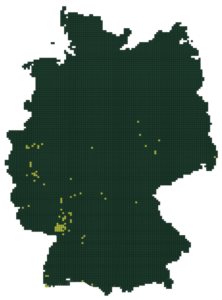Paulownia tomentosa
Princess Tree
Paulownia tomentosa, also known as the princess tree, originates from East Asia but has been introduced worldwide as an ornamental plant. The tree has gone wild in Europe, North America and Australia. Characteristic of the plant are its large, heart-shaped leaves and the striking blue-purple flowers. The tree is known for its fast growth rate - young specimens can grow up to 6 metres per year in the subtropics - and reaches a considerable height in just a few years. Paulownia tomentosa prefers disturbed sites and fertile soils and can grow in both sunny and semi-shady locations. It forms dense stands that can suppress other plants and thus impair local biodiversity. Nevertheless, it is still cultivated because of its attractive flowers and fast-growing wood.
Types of damage
Region of origin
East Asia

Introduction vectors
Current distribution
Based on the FlorKart Database of the Federal Agency for Nature Conservation, as of 2013
Miscellaneous
Dispersion forecast
Indicates the proportion of land suitable for habitat under current and future climate conditions (2060-2080) under three emission scenarios (RCP26, RCP45 & RCP85).

powered by Advanced iFrame. Get the Pro version on CodeCanyon.
Habitat suitability under current climate conditions
These habitat suitability maps show for Paulownia tomentosa where suitable habitat conditions exist.
The map on the left shows this for current climate conditions. Below this are maps for the time classes 2040-2060 and 2061-2080, in which three different emission scenarios can be selected.
The slider at the top left allows you to adjust the opacity of the map to make orientation easier.
By clicking on the respective quadrant, information on the environmental conditions present in it can be called up.
The methodology is explained here .
powered by Advanced iFrame. Get the Pro version on CodeCanyon.
powered by Advanced iFrame. Get the Pro version on CodeCanyon.














